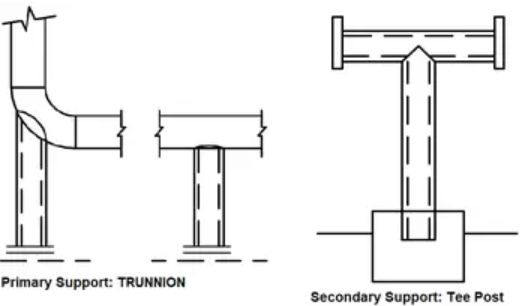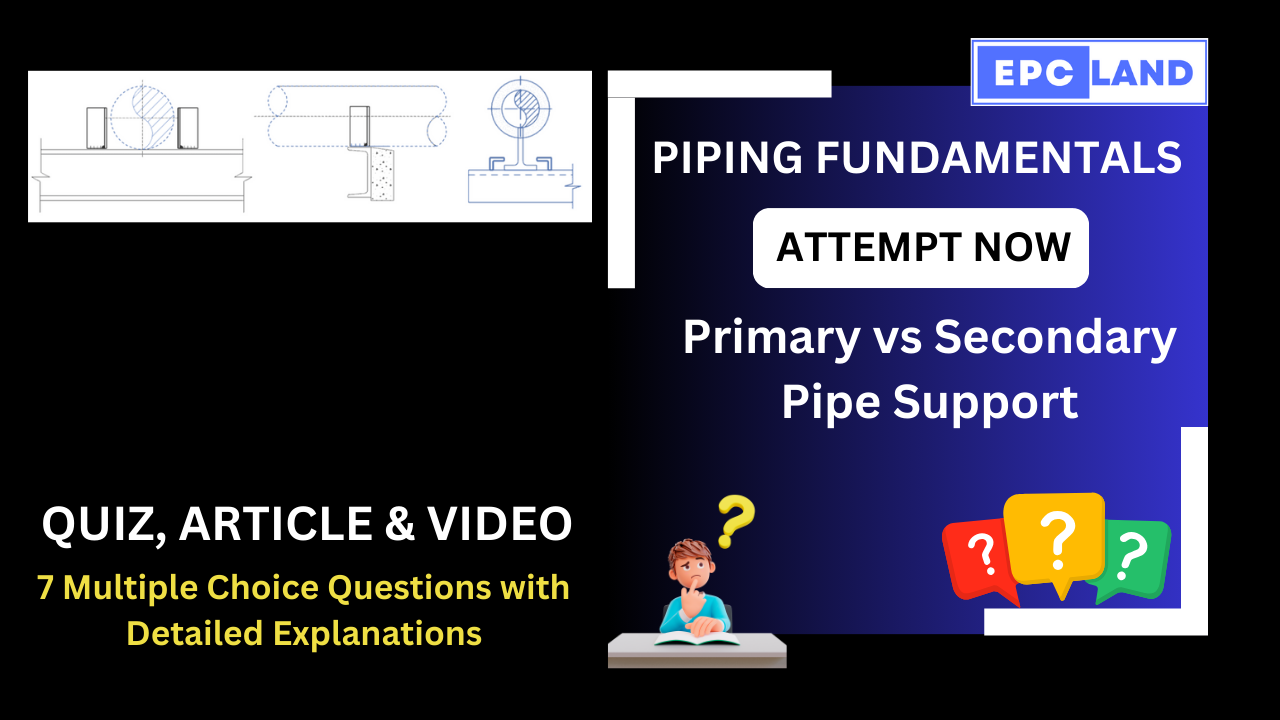
1. What is the primary function of primary pipe supports (Primary vs Secondary Pipe Supports)?
Choose the correct statement about primary supports w.r.t. Primary vs Secondary Pipe Support:
Explanation: Primary supports directly interact with the pipe, providing support and controlling movement.
2. What role do secondary supports play in the piping system?
Select the accurate description of secondary supports:
Explanation: Secondary supports provide the strength and stability needed for primary supports.
3. Which of the following is an example of a primary support?
Identify the primary support from the given options:
Explanation: Pipe shoes are examples of primary supports as they provide direct support to the pipe.
4. What is the attachment method for secondary supports?
Choose the correct statement regarding the attachment of secondary supports:
Explanation: Secondary supports are not directly connected to the pipe; they provide a stable foundation for primary supports.
5. What is the visibility of primary supports compared to secondary supports?
Choose the correct statement regarding the visibility of supports:
Explanation: Primary supports are more visible due to their direct connection to the pipe.
6. What is the underlying role of secondary supports?
Choose the accurate description of the role of secondary supports:
Explanation: Secondary supports provide the strength and stability needed for primary supports to fulfill their function.
7. What creates the true power of pipe support?
Choose the correct statement regarding the synergy between primary and secondary supports:
Explanation: The true power of pipe support lies in the synergy between primary and secondary supports, where each plays a vital role in ensuring the smooth and safe operation of the piping infrastructure.
Don’t Miss 20+ Quizzes on Pipe Supports:
Short Article on Primary vs Secondary Pipe Supports
Primary vs Secondary Pipe Supports: The Two Pillars of Stability
In the world of piping, two types of supports work hand-in-hand to ensure the stability and functionality of the system: primary and secondary supports. While they appear to be separate entities, they form a cohesive unit, each playing a crucial role in upholding the integrity of the piping.
Primary Supports: The Direct Guardians
Primary supports are the frontline defenders of the piping system. They are directly welded or attached to the pipe itself, acting as the first line of defense against gravitational pulls, thermal stresses, and vibrations. Think of them as the muscular arms that embrace the pipe, holding it firmly in place.
Examples of Primary Supports:
- Pipe shoes: Provide support and allow for axial and transverse movement.
- Clamps: Hold the pipe in place and offer flexibility for various pipe materials and diameters.
- Trunnions: Support both horizontal and vertical lines, acting as a pivot point for controlled movement.
- Wear pads: Protect the pipe from abrasion caused by sliding movement.
Secondary Supports: The Unsung Heroes
While primary supports take the spotlight, secondary supports play an equally vital role, acting as the foundation upon which the primary supports rest. They are the silent heroes, providing the strength and stability that the primary supports need to fulfill their function.
Examples of Secondary Supports:
- Steel structures: Beam frames and trusses that provide a robust platform for the primary supports.
- Civil foundations: Concrete structures built to withstand significant loads and ensure long-term stability.
- Sleepers: Wooden or metal blocks that distribute the load from the primary support to a larger area.
- Racks: Structures that support multiple pipelines in an organized and efficient manner.
The Synergy of Support
The true power of pipe support lies in the synergy between the primary and secondary elements. While the primary supports directly influence the pipe’s movement and stability, they require the unwavering support of the secondary structures to fulfill their role effectively. This creates a robust system where each element plays a vital part in ensuring the smooth and safe operation of the piping infrastructure.
Understanding the Differences:
Here’s a table summarizing the key differences between primary and secondary pipe supports:
| Feature | Primary Support | Secondary Support |
|---|---|---|
| Function | Directly interacts with the pipe, providing support and controlling movement. | Provides a stable foundation for the primary support. |
| Attachment | Welded or attached directly to the pipe. | Not directly connected to the pipe. |
| Examples | Pipe shoes, clamps, trunnions, wear pads. | Steel structures, civil foundations, sleepers, racks. |
| Visibility | More visible due to their direct connection to the pipe. | Less visible as they are the underlying support structure. |
In conclusion, both primary and secondary pipe supports are essential elements in ensuring the integrity and functionality of piping systems. Understanding their individual roles and the synergy between them is crucial for designing and maintaining safe and efficient piping infrastructure.
Table of Contents
Don’t miss the Course on Effective Isometrics Management: Check Now
Enrollment Link
Recommended courses (Published on EPCLand)
- Complete Course on Piping Engineering
- Basics of Piping Engineering
- Piping Layout Engineering
- Piping Material Engineering
- Piping Stress Analysis
- Material Requisitions
- Piping Material Specifications
- Valve Material Specifications
- Plant Design & Layouts-OISD 118
- Isometric Management
Library of Technical Articles
Don’t miss out the collection of 15+ articles on following topics:
- Basics of Oil and Gas Industry
- Valves
- Testing
- Tank
- Piping Bulk Items
- Pipe
- Metallurgy
- Piping Materials
- Layout
- Instrumentation
- Heat Exchanger
- Type of Contracts
- Codes and Standards
- ASTM Standards
- Articles on Piping Specialty Items
Video details of Complete Course on Piping Engineering
Why Enroll in the EPCLand
Proven Track Record– PTR
Activities & Achievements before launching EPCLand
- Published more than 50+ short courses
- 3000+ Enrolments
- More than 3,500,00 Minutes of watch hours in the last 2 years
- 4000+ Students in 100+ Countries
- Rating of 4+ out of 5
- 1000+ YouTube Videos
- 8K+ Subscribers
What Students will Learn
- Codes & Standards of the Energy Sector
- Piping Material Engineering
- Piping Layout Engineering
- Stress Analysis
Interesting facts
- All the published courses have been developed by Industry Experts with more than 2 decades of experience
- Content is based on Practical experience and real-time problems.
- Content is designed and organized in such a manner that it can be easily grabbed.
- Complete website, Blogs and Quiz sections are Planned, Designed and published by myself (About me: Atul Singla)
- Complete flexibility of Time & Location, Students can access the content from anywhere & anytime
- Moreover, once enrolled, the content can be access as many times as you want, which helps in understand the fundamentals in a better way.
Conclusion
In conclusion, our courses are meticulously crafted by industry experts with over two decades of hands-on experience. The content is rooted in practical knowledge, addressing real-time problems. The material is thoughtfully designed and organized for easy comprehension. Every aspect, from the website to blogs and quizzes, has been planned, designed, and executed by Atul Singla, ensuring a comprehensive and seamless learning experience. With the flexibility of accessing the content at any time and from any location, students have the freedom to learn on their terms. Furthermore, enrollment grants unlimited access, allowing learners to revisit the material as often as needed, fostering a deep understanding of the fundamentals.



